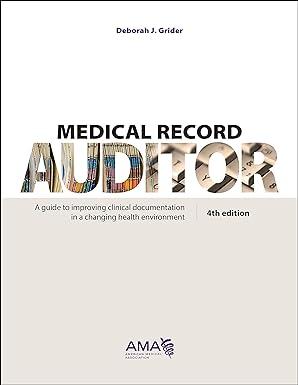Question
1. Which of the following methods allocates joint costs using a measure such as pounds, gallons, or inches at the split-off point? a.weighted average method
1. Which of the following methods allocates joint costs using a measure such as pounds, gallons, or inches at the split-off point?
a.weighted average method
b.net realizable value method
c.physical units method
2.
Johnson Lumber Mill produces various grades of cut boards from raw lumber. The costs incurred before the split-off point where the cut boards are separated and processed further are
a.investment center costs
b.new costs that cannot be traced to the various grades of lumber being produced
c.new costs that can be traced to the various grades of lumber being produced
d.joint costs that cannot be separated
3.
Which of the following statements is false about joint manufacturing processes?
a.Companies producing joint products often allocate joint costs to individual products.
b.Joint costs are by definition inseparable.
c.Joint manufacturing processes are simple and rarely require careful attention from managers when analyzing and interpreting product costs that include joint costs.
d.Product costs are more accurate if joint costs are allocated to individual products.
4.
When a single manufacturing process generates multiple outputs, it is called a(n)
a.activity-based manufacturing process
b.joint manufacturing process
c.joint activity manufacturing process
d.multiple output manufacturing process
5.
The weighted average method uses weight factors in conjunction with physical measures because
a.physical units alone are sufficient to provide the most reasonable allocation method
b.the joint process includes a product that requires extra machine time and creates greater wear and tear on the processing machines
c.the market value of the joint process should be weighted more heavily towards one of the products
d.the net realizable value of one product is greater than that of another product made with the same joint process
6.
Using the reciprocal services method, which of the following equations represents the algebraic expressions for the two equations needed to capture the total costs of a Janitorial Department (J) that includes not only $350,000 of direct costs but also 30% of the Maintenance Department (M) cost and the Maintenance Department that includes not only $50,000 of direct costs but also 50% of the Janitorial Department?
a.J = ($350,000 0.30) + M and M = ($50,000 0.50) + J
b.J = $350,000 (0.30 M) and M = $50,000 (0.50 J)
c.J = $350,000 + (0.30 M) and M = $50,000 + (0.50 J)
d.J = $350,000 + (0.30 M) and M = $50,000 + (0.50 J)
7.
Which of the following statements is true about the direct method of allocating support department costs to production departments?
a.The direct method requires that the same cost driver be used for each support department.
b.The direct method allocates all support department costs directly to production departments thus ignoring the possibility that some support departments may also serve other support departments.
c.The direct method is more difficult to use than the sequential method.
d.The direct method allocates only some of the support department costs directly to production departments and is more accurate than the reciprocal services method.
8.
When multiple production department rates are used to apply overhead to products,
a.support department costs are allocated to production departments and then all overhead costs are directly traced to support and production departments
b.all overhead costs are first directly traced to support and production departments and then support department costs are allocated to production departments
c.all manufacturing costs are first directly traced to support and production departments and then support department costs are allocated to production departments
d.only fixed overhead costs are first directly traced to support and production departments and then support department costs are allocated to production departments
9.
Which of the following statements is true about the four common methods for allocating joint costs?
a.It is impossible to determine whether one of the four methods may be more appropriate than another based on the production process.
b.The market value at split-off method is always the least appropriate method for allocating joint costs.
c.None of the methods will consistently allocate joint costs more accurately than another.
d.The net realizable value method is always the least reliable method for allocating joint costs.
d.market value at split-off method
Step by Step Solution
There are 3 Steps involved in it
Step: 1

Get Instant Access to Expert-Tailored Solutions
See step-by-step solutions with expert insights and AI powered tools for academic success
Step: 2

Step: 3

Ace Your Homework with AI
Get the answers you need in no time with our AI-driven, step-by-step assistance
Get Started


